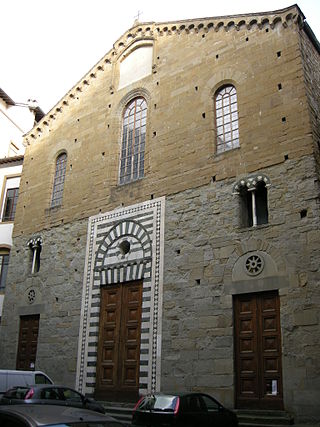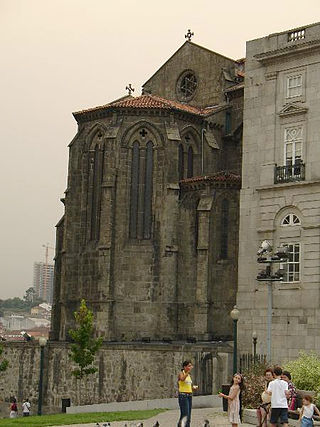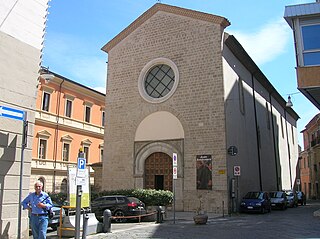
Romanesque architecture is an architectural style of medieval Europe that was predominant in the 11th and 12th centuries. The style eventually developed into the Gothic style with the shape of the arches providing a simple distinction: the Romanesque is characterized by semicircular arches, while the Gothic is marked by the pointed arches. The Romanesque emerged nearly simultaneously in multiple countries ; its examples can be found across the continent, making it the first pan-European architectural style since Imperial Roman architecture. Similarly to Gothic, the name of the style was transferred onto the contemporary Romanesque art.

Lodi is a city and comune in Lombardy, northern Italy, primarily on the western bank of the River Adda. It is the capital of the province of Lodi.

Baroque architecture is a highly decorative and theatrical style which appeared in Italy in the early 17th century and gradually spread across Europe. It was originally introduced by the Catholic Church, particularly by the Jesuits, as a means to combat the Reformation and the Protestant church with a new architecture that inspired surprise and awe. It reached its peak in the High Baroque (1625–1675), when it was used in churches and palaces in Italy, Spain, Portugal, France, Bavaria and Austria. In the Late Baroque period (1675–1750), it reached as far as Russia, the Ottoman Empire and the Spanish and Portuguese colonies in Latin America. In about 1730, an even more elaborately decorative variant called Rococo appeared and flourished in Central Europe.

Potenza is a comune in the Southern Italian region of Basilicata.

Atessa is an municipality in the province of Chieti, Abruzzo, south-eastern Italy. It is part of the Val di Sangro mountain community. It is the largest municipality in the province by extension and eighth by population.

Spanish Baroque is a strand of Baroque architecture that evolved in Spain, its provinces, and former colonies.

French Baroque architecture, usually called French classicism, was a style of architecture during the reigns of Louis XIII (1610–1643), Louis XIV (1643–1715) and Louis XV (1715–1774). It was preceded by French Renaissance architecture and Mannerism and was followed in the second half of the 18th century by French Neoclassical architecture. The style was originally inspired by the Italian Baroque architecture style, but, particularly under Louis XIV, it gave greater emphasis to regularity, the colossal order of facades, and the use of colonnades and cupolas, to symbolize the power and grandeur of the King. Notable examples of the style include the Grand Trianon of the Palace of Versailles, and the dome of Les Invalides in Paris. In the final years of Louis XIV and the reign of Louis XV, the colossal orders gradually disappeared, the style became lighter and saw the introduction of wrought iron decoration in rocaille designs. The period also saw the introduction of monumental urban squares in Paris and other cities, notably Place Vendôme and the Place de la Concorde. The style profoundly influenced 18th-century secular architecture throughout Europe; the Palace of Versailles and the French formal garden were copied by other courts all over Europe.

Tursi is a town and comune in the province of Matera, in the southern Italian region of Basilicata.
Stigliano is a town and comune in the province of Matera, in the Basilicata region of southern Italy.

Santo Stefano al Ponte is a Romanesque-style, Roman Catholic church, located in the Piazza of the same name, just off the Via Por Santa Maria, near the Ponte Vecchio, in Florence, region of Tuscany, Italy. The church is presently used as a concert hall.

The Church of Saint Francis is the most prominent Gothic monument in Porto, Portugal, being also noted for its outstanding Baroque inner decoration. It is located in the historic centre of the city, declared World Heritage Site by UNESCO.

Gothic architecture appeared in the prosperous independent city-states of Italy in the 12th century, at the same time as it appeared in Northern Europe. In fact, unlike in other regions of Europe, it did not replace Romanesque architecture, and Italian architects were not very influenced by it. However, each city developed its own particular variations of the style. Italian architects preferred to keep the traditional construction methods established in the previous centuries; architectural solutions and technical innovations of French Gothic were seldom used. Soaring height was less important than in Northern Europe. Brick rather than stone was the most common building material, and marble was widely used for decoration. In the 15th century, when the Gothic style dominated both Northern Europe and the Italian Peninsula, Northern Italy became the birthplace of Renaissance architecture.

The architecture of Georgia refers to the styles of architecture found in Georgia. The country is exceptionally rich in architectural monuments. Characteristic features of the Georgian architecture are monumentality, clear composition, strict proportions, moderate use of decorations, and above all these the harmonic interaction with nature.

Romano-Gothic is a term, rarely used in writing in English, for an architectural style, part of Early Gothic architecture, which evolved in Europe in the 12th century from the Romanesque style, and was an early style in Gothic architecture. In England "Early English Gothic" remains the usual term. The style is characterized by rounded and pointed arches on a vertical plane. Flying buttresses were used, but are mainly undecorated. Romanesque buttresses were also used. Romano-Gothic began to use the decorative elements of Gothic architecture, but not the constructional principles of more fully Gothic buildings. However, the walls did start to become thinner by using some pointed arches and ribbed vaults to distribute weight more evenly.

Churches and Convents of Goa is the name given by UNESCO to a set of religious monuments located in Goa Velha, in the state of Goa, India, which were declared a World Heritage Site in 1986.
San Michele Arcangelo is a romanesque-style Roman Catholic church in the city of Potenza, region of Basilicata, Italy.

San Francesco is a romanesque-Gothic-style Roman Catholic church in the city of Potenza, region of Basilicata, Italy.

San Rocco is a Roman Catholic church located in the city of Potenza in the region of Basilicata, Italy.

San Michele Arcangelo is a Roman Catholic church located on Largo San Gianuario, in front of the more imposing church of San Gianuario in the town of Marsico Nuovo, province of Potenza, region of Basilicata, Italy.
The Chiesa della Madonna del Carmine is a Roman Catholic church located on Via Raia Occidentale in the town of Marsico Nuovo, province of Potenza, region of Basilicata, Italy.

















